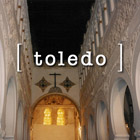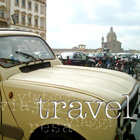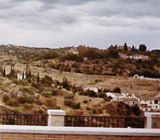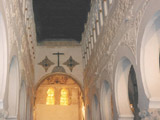
|
TOLEDO: A HIGH DAMASQUINADO PERCH Toledo is a fortified city, perched high on a hill overlooking the winding Río Tajo (Tagus River). A city of great historical import to the evolution of Spanish civilization, Toledo served as capital of Spain during much of its existence. Its imposing geographical stature gave the city a great military advantage in medieval times, and into the present, enabling it to outlast or overcome a number of brutal seiges throughout its history.
Toledo was already known in Roman times, according to Titus Livius, as a fortified city, and has since stood as a strategic objective of wave after wave of rulers and conquerors. An illustrious series of occupiers has held the city, for strategic and administrative purposes. In prehistoric times, the city was inhabited by Iberian tribes, then later by Celtiberians (Iberian Celts from the north). In the 2nd Century BC, it was captured by the Romans. In 411 AD, it was abandoned to Germanic nomads, who left little trace, and in 453 were overtaken by the Visigoths. Visigoth rule in Spain contributed many important features to Spanish culture that would last through the centuries and serve as a unifying force for insurrection against Muslim rule. The Visigoths introduced an impassioned derivation of Christianity, which the Catholic Church considered heretical. But on 8 May 589, Visigoth Spain was converted to Roman Catholicism when King Recarred pledged his allegiance to the Pope. This made the Catholic Church a fundamental organizing structure in Spanish society, a feature which endures up through the 20th Century. The power of the Church would spark many bloody conflicts and is now a less vital a part of the primarily secular Constitutional Monarchy. The Visigoths also formed a codified legal system, a central government and a regime of taxation to finance their rule. They ruled Spain for 300 years, and their descendents remained under future rulers. There is supposed to have been extensive mixing of Gothic and Iberian blood, but little in the way of architecture, artwork or scholarship was left behind. A study of Visigoth artifacts at the Santa Cruz Museum will lead to the judgement that the Visigoths were not concerned with refined or grandiose structures or carvings, but James Michener, the quintessential traveler who's Iberia is a defining tour of Spain, recommends one particular stone artifact as "one of the best things in Spain". Moorish Muslims arrived in 712, from North Africa. According to legend, it was the sexual aggression of King Roderick that prompted his victim's father to summon the Moors into Spain and to lead them to Toledo, where Roderick vanishes from history. The true story is not known, but the Muslims would establish a vital and diverse rule on the Peninsula and would continue to govern throughout parts of Spain until 1492. In 1085, the Spanish reconquest came to Toledo, and the city became part of the newly united peninsular monarchy. Toledo made its name as a foremost producer of weapons and armor, and to this day, visitors can purchase trinkets that harken back to that illustrious, chivalrous past.
Muslim rule left a number of curious influences, expressed most eloquently by the beautiful Sinagoga de Santa María la Blanca: a single structure used throughout its life by Muslims, Jews and Christians for worship. The building served toledanos as mosque, synagogue and church, and stands today as a centerpiece of the tourist route that illustrates a legacy of interreligious tolerance and productive coexistence. The legend of tolerance is perhaps exagerrated, and certainly Spain has seen various bloody purges based on religious faith, but that tolerance is attractive to modern Spaniards and is still considered to be part of what brought prosperity and higher learning to Toledo when much of the Continent was mired in the Dark Ages. Gothic, Mozárabe and Mudéjar designs come together to create an urban fabric like no other. There is a unique an incomparable blend of architectural heritage and civic function, spanning epochs of openness, eminence and persecution, which gives Toledo its profoundly textured, resonant character. All of this would be enough to warrant a trip to Toledo, but the Renaissance brought even more depth to the historic capital. The artist, Domenico Theotocopuli, better known as El Greco, lived here, and he documented not only the waifish emphatic saints he's known for, but also the people and the landscape of his hometown. His paintings, if not located here, feature the surrounding landscape, the sometimes foreboding but graceful cloud-cover that overtake the city on gray days, and the nobles and bishops that ruled during his day. His brilliant colors offer a sense of how the imagination deals with the sparse and unforgiving Castilian landscape, how the artist filled the psychological niches left unattended by the atmosphere of his times. [Full Story] |
|||||||||||||||||||||||||||||||||||||||||||||||
|
||||||||||||||||||||||||||||||||||||||||||||||||


 :: The arte toledano, or damas-quinado, is classic feature of Toledo's mystique. This is the only city in Spain where the art of inlaying tricolored gold into burnt steel is still practiced by hand, though much of what you'll find in the shops is machine made.
:: The arte toledano, or damas-quinado, is classic feature of Toledo's mystique. This is the only city in Spain where the art of inlaying tricolored gold into burnt steel is still practiced by hand, though much of what you'll find in the shops is machine made. 













